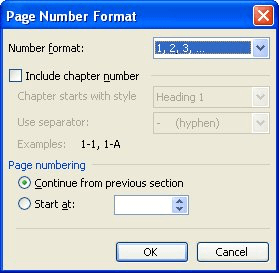Written by Allen Wyatt (last updated December 7, 2019)
This tip applies to Word 97, 2000, 2002, and 2003
Pam wrote about a problem she was having with getting chapter-number prefixes to appear in her index and table of authorities. She could get the chapter number to appear in the table of contents, but not the other two elements.
Word is capable of using either of two general formats for page numbering: It can use either a number by itself, or it can use a combination of a prefix followed by a number. However, it can use only a one-page format in a given file. You set the format you want to use for a document by choosing Page Numbers from the Insert menu, and then clicking on the Format button. Word displays the Page Number Format dialog box. (See Figure 1.)

Figure 1. The Page Number Format dialog box.
In the Page Number Format dialog box, you can specify if Word is to include the chapter number with page numbers it generates.
In order for chapter-number prefixes to work, the prefix must be a numbering format selected for one of the built-in heading styles that come with Word. This means that in order to include this prefix, your chapter heading style must be numbered. This would result in all chapters starting with a number, which is generally not the way chapters start. To prevent this, the number that Word adds to the chapter heading must be formatted as hidden.
The general steps then will be to first use a Heading style for your chapter name and number. Then, number the chapter headings using hidden text, pick a page format that will use heading numbers, and then create your Indices, Table of Contents, Table of Authorities, etc. The steps are:

Figure 2. The Customize Outline Numbered List dialog box.

Figure 3. The Font dialog box.
When you create your index or other special tables, the page numbers will show with the chapter-number prefixes in place. Because each chapter is a separate file, you must do this for each chapter, making sure to pick the appropriate start-at number in step 6.
WordTips is your source for cost-effective Microsoft Word training. (Microsoft Word is the most popular word processing software in the world.) This tip (1588) applies to Microsoft Word 97, 2000, 2002, and 2003.

Do More in Less Time! An easy-to-understand guide to the more advanced features available in the Microsoft 365 version of Word. Enhance the quality of your documents and boost productivity in any field with this in-depth resource. Complete your Word-related tasks more efficiently as you unlock lesser-known tools and learn to quickly access the features you need. Check out Microsoft 365 Word For Professionals For Dummies today!
When you construct an index you need to insert all sorts of index fields throughout your document. If you want to later ...
Discover MoreWord provides many options for creating indexes. One option allows you to specify that the index contain only entries ...
Discover MoreAfter you get your document ready for indexing by inserting index fields throughout it, you may want to index only a ...
Discover MoreFREE SERVICE: Get tips like this every week in WordTips, a free productivity newsletter. Enter your address and click "Subscribe."
There are currently no comments for this tip. (Be the first to leave your comment—just use the simple form above!)
Got a version of Word that uses the menu interface (Word 97, Word 2000, Word 2002, or Word 2003)? This site is for you! If you use a later version of Word, visit our WordTips site focusing on the ribbon interface.
Visit the WordTips channel on YouTube
FREE SERVICE: Get tips like this every week in WordTips, a free productivity newsletter. Enter your address and click "Subscribe."
Copyright © 2026 Sharon Parq Associates, Inc.
Comments